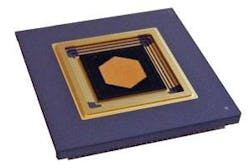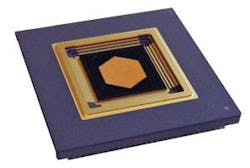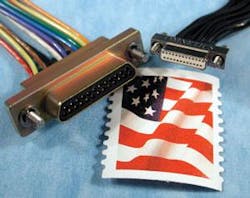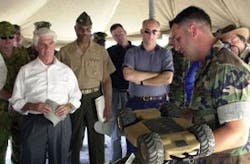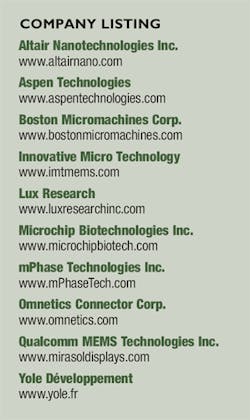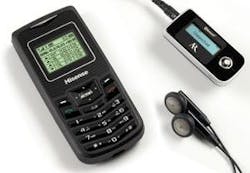MEMS and nanotechnology continue to solve challenges in military and defense applications.
By Courtney E. Howard
Size—along with weight, power, and cost (commonly referred to as SWaP-C)—is a central concern of today’s warfighters, and of the systems designers who serve them. An ever-increasing need for system portability exists for soldiers in the field.
Part of the network-centric battlefield, they need to be connected and informed, but must not be laden down with heavy, awkward electronics to do so. Technology firms serving the defense market endeavor to increase systems capabilities while decreasing size; one way they are accomplishing this goal is through the employ of nanotechnology and micro-electro-mechanical systems (MEMS)—the “technology of the small.”
Nanotechnology in biodefense
Microchip Biotechnologies Inc. (MBI) of Dublin, Calif., is harnessing nanotechnology to the benefit of the military and civilian populace. Engineers at MBI are hard at work developing a system capable of detecting biological warfare agents, even in small, bead-size concentrations.
MBI engineers are producing a prototype of the NanoBioSentinel, a hand-held nanofluidic device able to detect biowarfare agents. Their goal is to design, build, test, and commercialize an advanced nanofluidic, microchip-based, automated nucleic acid and immunoassay analyzer.
The NanoBioSentinel will input liquid samples from various sources, including aerosol sprays and wipes, and use bead-based techniques to capture and purify target organisms. Following capture and cleanup processes, two orthogonal on-chip analyses will detect threats with few false alarms, says a company representative.
The U.S. Department of Defense, through the U.S. Army Edgewood Chemical Biological Center (ECBC) at Aberdeen Proving Ground, Md., has awarded MBI a $365,000 Small Business Innovation Research (SBIR) Phase II one-year contract to continue developing its NanoBioSentinel. The Army ECBC serves as the nation’s lead science and technology center for chemical and biological defense products and services. The award is renewable for a second year and an additional $265,000, bringing the total potential value of the contract to $730,000.
“This Phase II award validates MBI’s vision for the NanoBioSentinel, an integrated solution that will prepare and analyze bioagent samples at great sensitivity,” says Stevan Jovanovich, MBI’s president and chief executive officer. “It will exploit nanofluidics to enable multidimensional analysis with excellent sensitivities and exquisitely low false-alarm rates.”
Naval nanobatteries
Just as size is a concern to the warfighter in the field, so too is power. Soldiers require safe and reliable devices that deliver big power in small packages. Because traditional batteries are heavy and bulky, the search for alternative power sources is on, and it involves nanotechnology.
U.S. Navy officials, recognizing the need for novel power supplies, contracted Altair Nanotechnologies Inc., a provider of advanced ceramic nanomaterials technology located in Reno, Nev., to develop the first battery backup power systems for Naval applications. This $2.5 million contract is part of a $3.3 million Navy program that includes independent product testing by the Navy.
Altair personnel will produce an optimized battery cell using the company’s nano-sized lithium titanate (n-LTO) electrode materials, as well as demonstrate the performance and safety attributes of the cell. Altair will also develop and demonstrate a modular system design for employing the new battery cell technology in several military applications, including energy and power storage for naval scenarios.
“Warships, in particular, run two generators continuously, one to supply energy and one to provide a backup energy source. The fuel cost for the backup is staggering,” admits Alan J. Gotcher, Altairnano CEO and president. “This is a validation test program for our disruptive battery technology.”
Army tests nanobattery
“Moore’s Law tells us that the number of transistors that can be packed on a single integrated circuit will double every 18 months. It is the law that has powered the exponential growth and miniaturization of electronics and digital devices. Unfortunately, one component hasn’t kept pace. Since its invention, the battery’s performance has only increased about eight fold…until now.” So begins a popular YouTube video, having garnered more than 41,000 views, from mPhase Technologies Inc. of Little Falls, N.J.
Engineers at mPhase and its wholly owned subsidiary AlwaysReady Inc. have incorporated nanotechnology into a revolutionary battery architecture for defense, space exploration, homeland security, and emergency services applications with help from the U.S. Army.
The Smart Nanobattery is an electrochemical system that delivers not only energy storage and power management, but also remote activation, programmable power, a shelf life that spans decades, and several configurations.
A prototype of mPhase/AlwaysReady’s smart reserve nanobattery was deployed in a gun-fired test at the Army’s Aberdeen Proving Ground earlier this year. The U.S. Army Armament Research, Development, and Engineering Center (ARDEC) at Picatinny Arsenal, N.J., conducted the test to evaluate the prototype as part of its cooperative research and development agreement with AlwaysReady.
During the event, the nanobattery delivered power to a load inside a standard military anti-tank round in the M830A1 high explosive anti tank (HEAT) shell. The nanobattery proved resilient, surviving the harsh environment and high acceleration at a force in excess of 45,000 Gs.
Engineers at AlwaysReady and Picatinny collaborated on the development of the reserve electrochemical storage system and its precision guidance components to enable their continued operation during the gun-firing and flight environment of a high “g” round. Developmental qualification work was performed at Picatinny’s air gun test facilities, where battery prototypes were subjected to various launch accelerations and design iterations.
“This battery successfully initiated on firing and operated flawlessly throughout the test,” says Carlos M. Pereira, the ARDEC Advanced Precision Concepts branch chief and principal investigator. “We are pleased that the AlwaysReady battery performed as intended, especially given the extremely harsh environmental conditions of the test. This will facilitate further development of our guidance systems.”
The long-term goal is to incorporate this battery technology into smart, gun-fired munitions programs being developed at Picatinny, says a company executive. Representatives also demonstrated the lithium-based Smart NanoBattery at this year’s NanoBusiness Alliance Conference and Exhibition in New York City.
“This is the first public activation of a prototype containing a lithium-based chemistry, a significant development milestone for the company,” said Allen of the event, at which mPhase/AlwaysReady personnel mechanically activated a lithium pouch-based reserve battery, illuminating an LED light in front of the live audience.
MEMS for military
MEMS, like nanotechnology, brings the promise of portability to military applications. MEMS are increasingly being adopted in the areas of infrared (IR) devices, optical and electrical switching, displays, inertial navigation, optical communications, printing, sensors, night vision, IR emitters, RF devices, and power management.
“MEMS are a significant improvement in portability,” recognizes Robert Stanton, director of technology at Omnetics Connector Corp. in Minneapolis. “With size, weight, and even power supply demands reduced, many functions can be transmitted to the source of the action, or what we are monitoring, or processing in a military operation.”
For example, says Stanton, “The economy of lower size and weight allows soldier-borne systems in the field on every member of a team and reduces the dependence for networked information through home-based operations centers and increases demand for high-capacity batteries. The size reduction enhances agility of the foot soldier and increases his communication with his command, as it is needed.”
Reductions in size and weight also are exploding the potential of hand-launched unmanned aerial vehicles (UAVs) for intelligence, surveillance, and reconnaissance missions, notes Stanton. Another important application for which MEMS are being considered is military medicine. “One of the most common problems with field troops is vertigo after being around explosions,” he says. “MEMS stability sensors are in development and specifically aimed at military applications.”
MEMS technology also is attractive for space applications, Stanton says. “Space electronics demand more and more technology in smaller satellites. One advantage of MEMS is that the chip and mounting technology can be matched to the thermal coefficient of expansion of the satellite hardware much easier than larger electro-mechanical systems. As satellites go through geo-thermal cycles while in orbit around the Earth, a micro-electro-mechanical system will last much longer than electro-mechanical systems.”
Omnetics designs and manufactures micro and nano miniature interconnect products, such as commercial off-the-shelf (COTS), standard, and custom connectors for military, aerospace, and defense. Stanton reveals that Omnetics’ connectors are being investigated as key components of interchange-ability systems in the field. “MEMS can be completely sealed and survive the rigors of shock, vibration, and handling in miniature modules,” he says, “much better than other mounting techniques.” The company’s connectors have been adopted by military development labs, although the applications are confidential—even to Omnetics officials.
MEMS optics
MEMS are particularly beneficial for military communications, as warfighters carry increasingly smaller hand-held devices. “Generally speaking, MEMS technology offers the military a means of miniaturizing and improving existing technologies and using new technology,” says Paul Bierden, president and CEO, and Steven Menn, director of product marketing, of Boston Micromachines Corp. (BMC) in Cambridge, Mass.
Boston Micromachines Corp. in Cambridge, Mass., is a provider of MEMS-based deformable mirror products for adaptive optics systems. BMC engineers are developing two optical MEMS technologies for military end-use applications: MEMS deformable mirrors for laser communications (lasercom) and free space optics. “Deformable mirrors are used in adaptive optics—a method that corrects optical distortions,” Bierden explains. In laser communication, the optical distortions are in the atmosphere between the transmitter and receiver. Correcting for these distortions, also known as aberrations, results in higher fidelity and higher speed communication.
“MEMS deformable mirrors offer a significantly miniaturized spin on other deformable mirrors, with miniaturized electronics, and are especially important for air and space applications,” Bierden continues. In such scenarios, the deformable mirrors are faster with higher spatial resolution, improving communications. They are also a fraction of the weight and cost of other, non-MEMS deformable mirror systems, Bierden says.
SCOUT with MEMS
BMC engineers have been developing the Secure Communicating Optical Ultra-small Transponder (SCOUT) with help from research partner Boston University in Boston and a $100,000 Phase 1 Small Business Technology Transfer Program (STTR) award from the U.S. Army through the Department of Defense.
SCOUT is a miniature, low-power, ultralight transponder that is designed to protect soldiers from fratricide, explains Bierden, and to deliver secure, line-of-site, voice communication. SCOUT’s technology is based on a modulated retro-reflector, which combines a MEMS deformable mirror to modulate light with a simple optic that returns a reflected light to its point of origin.
“MEMS improves performance,” says Bierden of SCOUT. “The transponder is able to communicate at a higher speed and over a longer range than RF transmitters. MEMS technology also enables its small size and weight—approximately that of a matchbox—and low power. Low power translates into months of operation using a tiny lithium battery.”
SCOUT and its inherent MEMS technology are helping to address growing needs for military forces. The new device is expected to save lives on the battlefield through secure optical communication using an active mirror that enables the rapid identification of friend and foe, be it soldiers, vehicles, or aircraft. The device’s applications extend beyond friend or foe identification to include situational awareness, covert communication, and reading remote sensors.
To date, BMC engineers have designed and built a functional prototype, including the transponder and receiver, and also demonstrated successful communication with the device. “Our technology, which has helped advance applications in Department of Defense laser communications systems, will play an important role in the effort to save lives on the battlefield,” Bierden says.
It is clear that MEMS technology can improve performance over existing technologies, while reducing size, weight, and cost—three critical for elements for wide scale deployment, Bierden notes. “Ten years ago, MEMS technologies were just being developed. In the past five years, they have been proven. In the next five years, these advanced technologies will be employed in a wide range of military and commercial applications,” he predicts.
NanoGuardian combats global counterfeiting
NanoInk Inc., a technology company specializing in nanometer-scale manufacturing and applications development in Skokie, Ill., has launched NanoGuardian. The new business unit will focus on delivering brand protection solutions, using NanoInk’s NanoEncryption technology, to counterfeited markets.
The NanoGuardian division of NanoInk focuses exclusively on delivering brand protection solutions to fight illegal diversion and counterfeiting, says an official. NanoGuardian officials will harness NanoInk’s NanoEncryption technology to enable manufacturers to track, trace, and authenticate the integrity of their products across the supply chain.
With Dip Pen Nanolithography, a patented and proprietary nanofabrication technology, and high-resolution NanoEncryption technology, NanoGuardian provides a forensic-level track and trace brand protection at the unit level. “NanoGuardian’s NanoCodes can only be detected with specialized authentication tools located at NanoGuardian Authentication Centers,” according to a company representative. “Authentication testing is done quickly—within 24 to 48 hours—and in a non-destructive manner.
For more information, visit NanoGuardian online at www.nanoink.net.
Qualcomm MEMS display borrows from nature
Qualcomm MEMS Technologies Inc., a wholly owned subsidiary of Qualcomm Inc. in San Diego, has developed a direct-view MEMS display for mobile devices.
“The phenomenon that makes a butterfly’s wings shimmer is the same process used in Qualcomm’s mirasol displays,” says a company representative. The display employs interferometric modulation (IMOD), and works by reflecting light so that specific wavelengths interfere with each other to create color. This reflective technology mimics the mechanisms that naturally create vibrant colors in a butterfly’s wings.
The reflective mirasol display delivers impressive viewing quality in a range of environmental conditions and ambient light, including bright sunlight. Because the displays require no backlighting, they consume significantly less power than standard displays in portable devices.
KT Freetel (KTF), Korea’s first wideband code division multiple access wireless operator headquartered in Seoul, Korea, has selected Qualcomm’s MEMS-based mirasol display technology for its SHOW WCDMA Monitoring Systems.
WCDMA, officially known as IMT-2000, is a third-generation (3G) mobile wireless technology that promises high data speeds to mobile and portable wireless devices. KTF’s SHOW Monitoring System uses 3G WCDMA to transmit live video from a SHOW camera device to a designated mobile phone. The SHOW monitoring device also is equipped with motion sensors that send SMS alerts to the handset when there is physical activity near the base.
Yole Developpement delivers toolkit for MEMS industry players
Yole Developpement of Lyon, France, has released two databases to aid MEMS industry suppliers and investors in evaluating MEMS markets: World MEMS Market database 2008 (WM2) and the updated World MEMS Firms database (WMF).
WM2 delivers detailed MEMS product forecasts for various types of devices, such as sensors, microphones, accelerometers, gyroscopes, micro displays, microfluidics, RF MEMS, micro tips, micro fuel cells, and new emerging MEMS devices. Forecasts for each device are detailed by application (aeronautics and defense, industrial, consumer, automotive, medical, life science, and telecom).
“We see with this year’s World MEMS Fabs update a clear evolution of the Asiatic market and the disappearance of 75mm lines,” says Jerôme Mouly, MEMS technology and market analyst at Yole Developpement.
WMF describes more than 450 MEMS players worldwide, including business models, contact details, top executives, and technology information. For more information, visit Yole Développement online at www.yole.fr.
